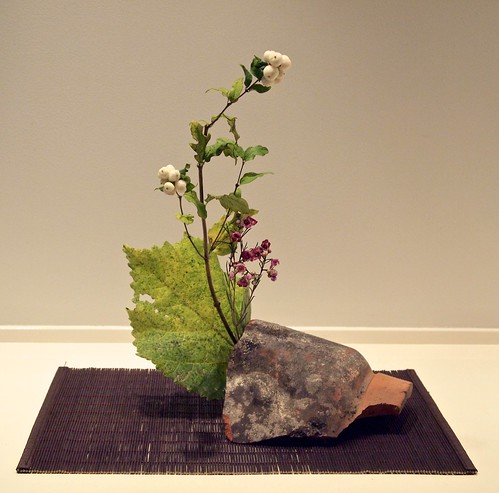Chabana, or tea flowers, is an integrated element of the Japanese tea ceremony. Chabana is a spontaneous type of flower arrangement, naturalistic and extremely simplistic. It's not even called an arrangement - the ideal is a natural "undesigned" look. On the one hand there are no rules for how to place the flowers. They are presented the way they grow in the nature and in a way that highlights their natural characteristics. On the other hand the chabana must always be in harmony with the tea ceremony as a whole and must therefore follow the season and the occasion of the ceremony.
Maple leaves is a beloved symbol of autumn in Japan. In this chabana I have chosen a single, rather tall branch and displayed it in a traditional metal vase. The idea is to show the natural beauty of the slanting maple branch and its fiery red leaves. Chabana with branches are most often smaller in size, so this is one is somewhat uncommon. Also, when arranging maple leaves the most popular way of showing off the leaves is to group them in a mass to get a strong colour effect.
Maple leaves is a beloved symbol of autumn in Japan. In this chabana I have chosen a single, rather tall branch and displayed it in a traditional metal vase. The idea is to show the natural beauty of the slanting maple branch and its fiery red leaves. Chabana with branches are most often smaller in size, so this is one is somewhat uncommon. Also, when arranging maple leaves the most popular way of showing off the leaves is to group them in a mass to get a strong colour effect.
Chabana, ishu-ike, Japanese Maple.
Basically there are three levels of formality in tea ceremony; formal, semiformal, and informal or shin, gyo and so. A tea master has many sets of utensils and equipments, so that there is always a set that suits the level of formality and the season. There are also variations in the way the ceremony is performed. The chado blog SweetPersimmon has a short and informative article about this that you can read on this link.
According to the book "The Art of Chabana: Flowers for the Tea Ceremony" by Henry Mittwer, the vases and boards (dai) that the vases are placed on can be classified by grade of formality in the following way:
Shin: Bronze vases and Chinese or other porcelainware. Lacquered black board with the edges routed in a V-shape.
Gyo: Glazed pottery. Lacquered baord wtih the edges tapered to a point.
So: Unglazed or semiglazed pottery and basketware. Unfinished cedar or paulownia wood (wet with water to make it appear fresh), or a round board with tapered edge.
All vases should be without decoration. Containers made from bamboo stalk are considered either gyo or so.
 "The Art of Chabana: Flowers for the Tea Ceremony"
"The Art of Chabana: Flowers for the Tea Ceremony"by Henry Mittwer
Tuttle; 1st edition 1974
ISBN: 0804811113


























.jpg)

